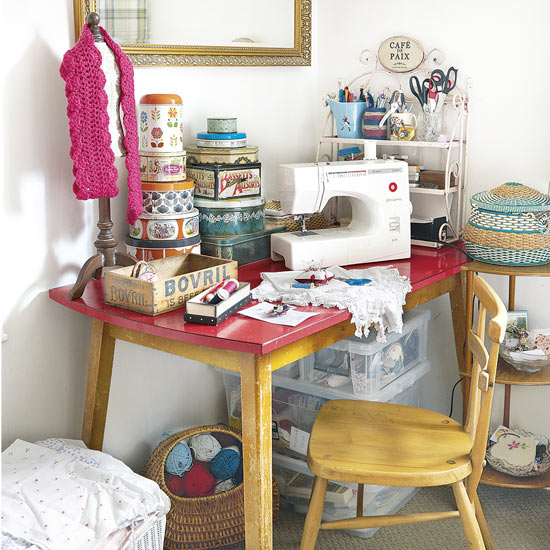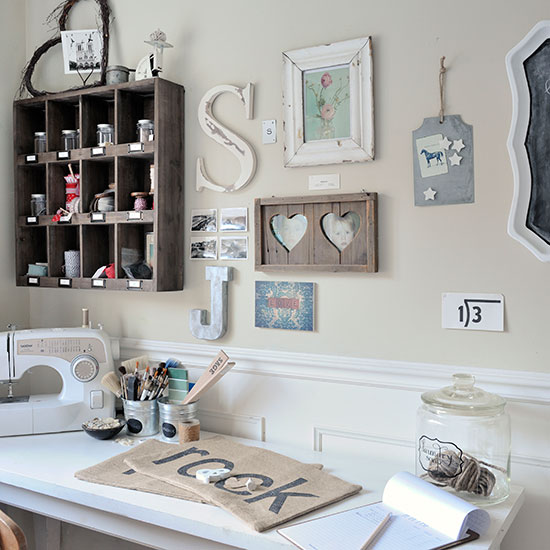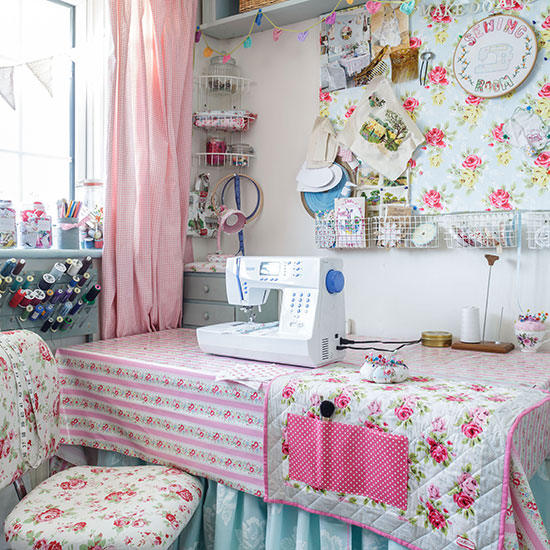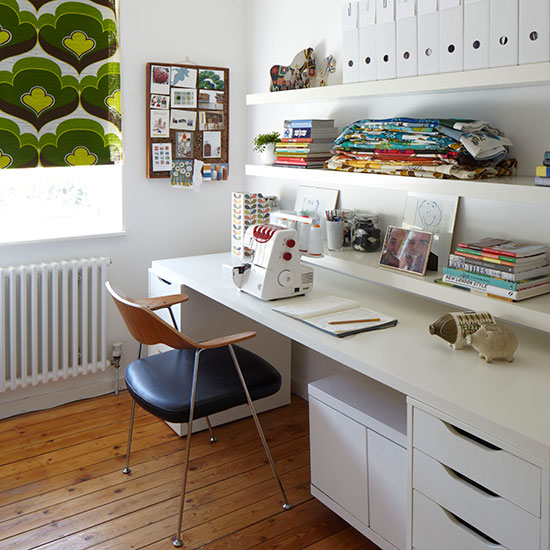13 craft room ideas to help you design a nurturing environment for your creativity and arts and crafts projects
Let your imagination and creativity run wild with the help of our craft room ideas

- 1. Go for inspiring, bold colours
- 2. Include enough storage
- 3. Repurpose old furniture
- 4. Pick a spot with sufficient natural light
- 5. Carve out a craft nook
- 6. Make the most of a small corner
- 7. Beautify with floral noticeboards
- 8. Utilise an unloved room
- 9. Incorporate objects that motivate you
- 10. Keep it neat and tidy
- 11. Pretty it up with wallpaper and fabrics
- 12. Give your space a considered aesthetic
- 13. Take your craft room outdoors

Sara Hesikova
Whether you’re a professional artist or dabble in personal arts and crafts projects, well thought-out craft room ideas for your creative space are a must in order to create an environment that will nurture your creativity and let your imagination and ideas blossom.
Similarly to home office ideas, your craft room should be a place that both inspires you with its decor and serves you in its practicality and functionality. So considering effective ways to organise your craft room and what pieces and features to include in it, whether it’s an existing space or a future plan, will really make the room come alive. And hopefully, become one of your favourite places to hang out and craft going forward.
1. Go for inspiring, bold colours

Just like there are ideal home office colour schemes to increase productivity, there are the perfect craft room colours – those that will inspire you. But unlike home offices, craft rooms don’t need to be productivity-inducing so you can go a bit more vibrant and bold with your shade choices.
‘Colour forms the backbone of any project and has the potential to set the tone of a room, whilst also being a way of expressing personality – especially important in a craft room,’ says Esme Amberg, head of design at The Roost. ‘Embrace bold colour to help transform the space, conjure inspiration and creativity. Mix and match patterns to create an eclectic space filled with your favourite things.’
You can also use colour and paint ideas to create zones in your craft room or if your craft nook is in a shared space, you can use colourful paint to section it off. ‘If your craft space is tucked in the corner of another room or open plan space, colour can also be a great way to zone the room to form a separate space just for you. Perhaps a coloured wall behind your desk, or graphic painterly shapes to add a pop of colour to an otherwise neutral room,’ Esme says.
2. Include enough storage

Much like home office storage ideas, keeping your craft room uncluttered and organised is also down to effective and sufficient storage solutions. And there are plenty of ways you can incorporate extra storage into your craft room.
‘Storage! Yes, it’s functional, but that doesn’t mean it has to be boring. Whilst storage needs to be a practical choice, the right pieces can bring your room to life whilst also making it more comfortable and enjoyable to spend time in. Utilise vertical space by adding shelving or cabinets, or you can free up valuable floor space by investing in multi-functional pieces that act as both furniture and storage. Having sufficient storage will help you keep on top of your crafting essentials and avoid disorganisation,’ Esme says.
Sign up to our newsletter for style inspiration, real homes, project and garden advice and shopping know-how
Rachel Fearnley of Rachel Fearnley Designs continues, ‘When planning your storage, can things from around the house be repurposed? For example, old glass jars for storing small craft items and some of your smaller tools too, or old biscuit tins or sweet containers from Christmas. I store pencils and crayons in an old treacle tin that has been thoroughly washed out. Ask family and friends to save old jars for you and you will soon have a good stash of useful, and free storage jars.’
‘Stacking boxes are great in small spaces as they enable you to store different materials, tools and resources in a relatively small space. Also consider using pretty fabric bags to store things in, these can be hung on the back of a door or from hooks on the wall. Vintage wicker baskets will also work well for storage while also looking pretty. Having different coloured boxes or containers is a useful trick that enables you to store your different craft equipment in the boxes. If you colour code these, life will become much easier when trying to find things and also when tidying up after your craft session. You will know where everything belongs,’ she concludes.

As Rachel suggests, utilising colour in your storage can make your life a lot easier. As well as more fun and stylish. Especially if you opt for a design like these multi-coloured fabric storage boxes with lids from Amazon. In fact, they're so popular that over 500 units have been sold in the past month alone.

While you can, of course, opt for a vintage basket to store your crafting supplies, if you don't have access to any, you can also buy a new storage basket like this Dunelm design. Woven from seagrass, this stylish basket is one of our go-to because of its low price point of mere £12.
3. Repurpose old furniture

Why not actually start crafting while in the process of transforming your craft room by upcycling old pieces of furniture to suit your creative needs? Whether that’s a desk or a storage unit.
‘Do you have pieces of furniture in your home that can be repurposed? For example, an old table that can be used as your craft table. Alternatively, furniture could be sourced from charity shops or online marketplaces. Join some local groups on social media and see whether anyone is offering pieces of furniture,’ Rachel suggests.
4. Pick a spot with sufficient natural light

To be able to craft well, you certainly need to see your project well as you’re working on it. So, if at all possible, choose a room or a spot in your home that receives enough natural light to allow you to create effectively.
‘A priority for a well-functioning craft room is good light, preferably natural light. If your craft requires the use of a table, I would suggest placing this as near to the window as possible for natural light. Cupboards or shelves which are used for storage can be placed in the darker areas of the room. Here you could include a table lamp to offer additional lighting,’ Rachel advises.
5. Carve out a craft nook

Put wasted areas to good use - the end of a hallway, under the stairs or a landing are all areas that could double-up as a compact work zone.
Here, a crafting area fits neatly under a sloping wall. Decorate a wall with wallpaper and fabric clippings and swatches that not only look pretty, but help to aid creativity.
Alternatively, pin your favourite designs to the wall in stylish frames for a smart display. When two distinct areas share a space, it's important to tie them together so they don't jar – use similar styles of furniture and a common colour palette.
6. Make the most of a small corner

Transform a tired, unloved corner into a craft room with a few fabulous finds. Scour flea markets, antiques fairs and boot sales for vintage furniture that doesn't cost the earth. Incorporate pieces that are not traditionally used in a craft room or home office. Here a plant stand functions as a practical unit to keep sewing materials organised.
7. Beautify with floral noticeboards

Why not pretty up a bare wall? For a simple and stylish solution where space is tight, or in a dual-purpose room where you don't want the office area to dominate, cover plain corkboards with patterned wallpaper or fabric that ties in with the rooms colour scheme. Alternatively, self-adhesive cork tiles are cheap and can be put up in minutes to turn a whole wall into an ever-changing collage of notes, photos and inspirational whatnots.
8. Utilise an unloved room

This craft room makes use of every inch of its cellar space. Storage is squeezed into every nook and cranny. For a neat and relaxed feel in your craft room, organise supplies in preloved bookcases, chests of drawers and shelves. This fuss-free approach keeps your materials in order, looks great and is inexpensive to pull off, even if you have an abundance of paraphernalia.
9. Incorporate objects that motivate you

Decorate your craft room with trinkets that will inspire and motivate you. Accessories give all the comforts of home for a welcoming work space. Hang framed artwork to give bare walls more personality and to make the space look more like the other rooms in your home.
10. Keep it neat and tidy

Be ruthless with clutter. If you know exactly what you want to store in your craft room, or you simply want to have everything hidden away and out of sight, then consider installing fitted units.
To keep the office from looking untidy stash things in boxes or behind cupboard doors for a streamlined finish. For a classic scheme that won't date, you can't beat the natural good looks of wood.
Alternatively, look in salvage yards for discarded standalone pieces. Don't be discouraged when sourcing salvaged wood - even when damaged, wood can often be restored to its former glory, so you can make the most of auction room acquisitions or junk-shop finds. You may even find an artist's preloved easel.
11. Pretty it up with wallpaper and fabrics

As well as using them for decoration, turn the walls of your office into a practical feature. Cover the wall so that it becomes a practical surface - cork tiles, magnetic paint or blackboard paint are all good options. You need to create a free area on at least one wall - the scale will depend on how much space you have, from a totally bare wall to a smaller section above a desk or shelving unit.
12. Give your space a considered aesthetic

Display your magazine files along an open shelf for easy access. Match them to the wall colour for a seamless, unobtrusive look or create a feature with a contrasting material. Keep the colours calm in a craft room or home office to promote a good working environment. To stop your space from looking too clinical, add a splash of colour through soft furnishings, but stick to one or two colours.
13. Take your craft room outdoors

If you need more space and you need it fast, an outdoor room could be the answer. They work particularly well as offices or studios and are often more cost-effective than travelling to and renting a space. Even the short walk down the garden can feel like 'going to work', plus they can be closed up at the end of the day.
Now you can get to the first creative endeavour which is designing your craft room before actually starting all your other projects in your new, inspiring space.

Holly Walsh has been Content Editor at Ideal Home since 2021, but joined the brand back in 2015. With a background of studies in Interior Design, her career in interior journalism was a no-brainer and her passion for decorating homes is still as strong as it ever was. While Holly has written for most of the home titles at Future, including Livingetc, Country Homes & Interiors, Homes and Gardens and Style at Home, Ideal Home has always been her ideal home, and she can be found sharing her expertise and advice across both the printed magazine and the website too.
- Sara HesikovaContent Editor
